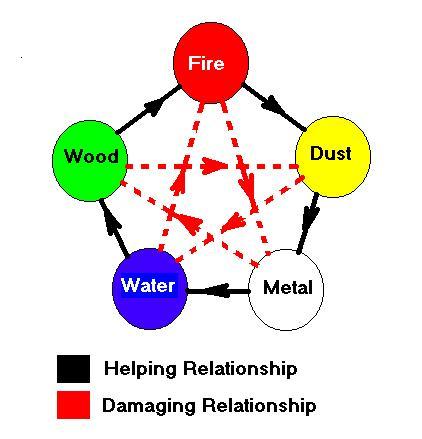It was thought that by balancing this trilogy, as with the equilibrium of yin and yang, that a good-life was attainable. The preaching was to live physically, mentally and ethically integrated within the rules of nature, which regulate heaven and earth and all in between.
We can find wood, fire, dust, metal, and water everywhere between heaven and earth. These scholars named them �the five elements�. Just about everything, including humans, live between heaven and earth, similar to the five elements. Therefore, it was thought that humans must have a relationship with the five elements. Much ingenuity was used to group almost everything into these five elements.
Wood: dragon, solidity & ease of workability, flexibility, liver and gallbladder, Spring, anger, stretching.
Fire: panther; combustion & the creation of heat; heart, blood vessels, nerves and the small intestines; Summer,
cardiovascular training.
Dust: snake; fertility and stability; stomach, spleen and the muscles; worry; Monsoon; strengnth training.
Metal: tiger; fusibility and power; lungs, large intestine, skin and hair; sadness; Autumn; tournaments.
Water: crane; fluidity; kidneys, bladder and the sexual organs; fear; Winter; learning new forms and meditation.
The idea that everything is connected has great significance in this theory. An excess or deficiency of one of the elements causes a reaction to the others in an effort to return equilibrium. This is seen after a very hot summer day (excess fire) when a storm erupts (water), to return balance.
Likewise, an excess or deficiency in one group of the elements will affect other sub-parts of that agent. If a person is excessively sad (metal), this may affect the lungs and present as asthma. In martial arts if a person does not practise dragon techniques (grappling), then this may weaken the tendons.
The five elements are best understood as phases of a constantly moving cycle. Each grows and replaces the next in much the same way as the season progresses. As there are affinity and enmity relationships among the Five Elements, there must be similar relationships among humans. For example, trees have their own growth cycle in between Heaven and Earth. Humans therefore must have lifecycles as well. The seasonal changes affect the growth of trees. Trees grow faster in the spring and slower in the fall. Without adequate sunshine, trees grow too slowly. Too much heat, trees will be dried out. Without water, trees cannot grow. Too much water, trees will be uprooted and afloat. Insufficient earth, tree will not grow tall.
When the seasons and environment change, the Five Elements have certain responses. Humans respond in a similar way. The scholars made predictions on the human lifecycle, from birth to death, by using this natural phenomenon.
The Five Elements can be broken down into yin and yang as yang wood, yin wood, yang fire, yin fire, yang dust, yin dust, yang metal, yin metal, yang water, and yin water. Many different cycles can be identified within the five elements, but the two most common are the mutually helping and destructive relationships.
From METAL we get WATER (Metal turns liquid when melted)
METAL is controlled by FIRE (When it is melted)
From WATER we get WOOD (Water assists plants grow)
FIRE is controlled by WATER (Water puts fire out)
From WOOD we get FIRE (Wood burns to create fire)
WATER is controlled by DUST (Dust can hold and absorb water)
From FIRE we get DUST (Fire creates ashes, which become part of the earth again)
DUST is controlled by WOOD (Trees and plants maintain earth structure and take nutrients)
From DUST we get METAL (All metals are extracted from the earth)
WOOD is controlled by METAL (All types of wood can be chopped or sawed)
This knowledge can be used with your kung fu to assist healing in accordance with traditional Chinese medicine, for example: a person may complain of trouble with their breathing and lungs as well as being depressed and sad. As these symptoms are classified as metal characteristics, dust exercises (countering grapples) and snake forms may be employed and panther techniques (leaps and low attacks) classified as fire would be restricted, as fire destroys or hinders metal. In this way the balance of energy in the body will be regained.
More simply, a training schedule is obvious according to where the qi is in the body during each season. In spring, nature is growing so stretching and grappling are in order. As summer arrives, the energy is out at the surface so cardiovascular and speed exercises that cause a sweet are beneficial. This leads to late summer where the trees have grown and are now thickening out. Strength and stance work should be done during this part of the year. Autumn is the harvest period so now is a time for sparring and tournament so as too display the fruits of your hard work. As winter arrives, the qi deepens into the body, consolidates and rests. Training that does not allow this can be dangerous in the next season. This is a period for meditation and learning new forms.
